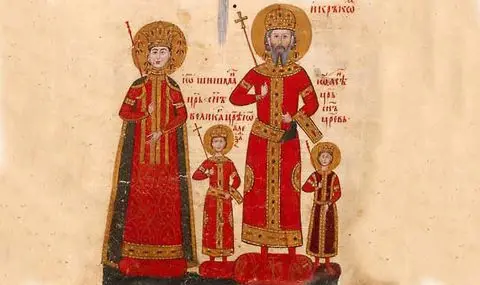On February 17, 1371, the Bulgarian Tsar Ivan Alexander dies.
After the death of the energetic Tsar Michael III Shishman-Assen (1323-1330) in the Battle of Velbuzhd (28.07.1330), a dynastic crisis occurs in Bulgaria.
The Serbian protege Ivan Stefan (1330-1331) is exiled
and in the struggle for the throne, the powerful Despot of Lovech Ivan Alexander wins – son of Despot Sratsimir and nephew of the late Tsar Mikhail Shishman, recalls the website istoriya.bg.
Tsar Ivan Alexander was born at the beginning of the 14th century and is considered a descendant of the Asenevtsi and the Terterovtsi. With military force, skillful diplomacy and dynastic marriages, he raised the Bulgarian medieval state as a cultural and spiritual center, but also experienced its disintegration.
During the first years of his reign, the king achieved military victories against Byzantium. In the Battle of Rusokastro (18.07.1332) Ivan Alexander defeated Andronicus III and concluded a peace treaty, according to which he annexed the Black Sea cities of Messemvria and Anchialo to Bulgaria. The treaty was sealed with the marriage of the heir to the throne Mikhail Asen to the daughter of the basileus.
Relations with Serbia were also settled. Ivan Alexander married his sister Elena to the young Serbian king Stefan Dušan. After that, Elena played an important role in Serbian politics.
From 1341 to 1347, a new civil war broke out in Byzantium between John Kantakouzenos and Anna of Savoy, mother and regent of the minor emperor John V Palaiologos. Kantakouzenos called on the Turks as allies and sent Umur Bey to the Bulgarian possessions in Dobrudja. This provoked the Bulgarian support of Anna of Savoy, who ceded Plovdiv, Stanimaka and Krichim to Ivan Alexander. Kantakouzenos called in new Turkish troops against the Bulgarians. On July 7, 1345, in a battle against the Romans and the Turks, the Rhodope voivode Momchil - the main defender of the Bulgarians - died. Thus, with the support of John Kantakouzenos, the Ottoman raids continued.
The Turkish attacks directly affected Byzantium, although John Kantakouzenos attracted them to the Balkans. In 1351, John Kantakouzenos (1347-1354) proposed an alliance to Bulgaria and Serbia and the creation of a common fleet against the Turkish invasions, but the distrust between the Balkan rulers thwarted this alliance. In 1352, the Ottomans captured Tsimpe, and in 1354 the fortress of Gallipoli, as a result of which John Kantakouzenos abdicated and John V Palaiologos (1354-1376) ascended the throne.
During the period 1349-1355, the Ottoman raids reached as far as Sredets (Sofia), where the sons of Ivan Alexander died in the battles – Michael Asen IV and Ivan Asen IV.
In 1355, Bulgaria and Byzantium concluded a new alliance, but it also proved unsuccessful. Ivan Alexander divorced the Wallachian Theodora I and married the Jewish Theodora II, declaring his son from his second marriage, Ivan Shishman, as heir to the throne. In 1356, Ivan Sratsimir declared himself the independent ruler of the Vidin Kingdom. In Dobrudzha, Despot Dobrotitsa ruled independently, whom Tsar Ivan Alexander himself bestowed in 1369 with a despotic crown and the fortresses of Varna, Emona, Kozyak and Drastar, for his help in expelling the Magyars from Vidin.
In 1364 John V Palaeologus again captured Messemvria and Anchialos, Ivan Alexander sought Turkish help, but Count Amedeo VI of Savoy intervened and took the Black Sea Bulgarian cities in favor of Byzantium.
Due to feudal fragmentation and struggles for supremacy, relations between the Balkan states became increasingly disunited. In 1369, Murad I conquered Edirne, and in 1370, Plovdiv and Boruy (Stara Zagora) and became an immediate threat to the Kingdom of Tarnovo.
Tsar Ivan Alexander died on February 17, 1371.
His reign was accompanied by the religious movement of Hesychasm and new persecutions against the Bogomils.
Church councils against heretics were held in Tarnovo. Ivan Alexander proved to be an exceptional patron and donor. Notable cultural monuments are the London (Ivan-Alexandrovo) Four Gospels, the Bulgarian translation of the Chronicle of Manasseh and other books with artistic miniatures. A rich medieval culture flourished in Bulgaria and the Tarnovo School of Painting and Literature was established.
